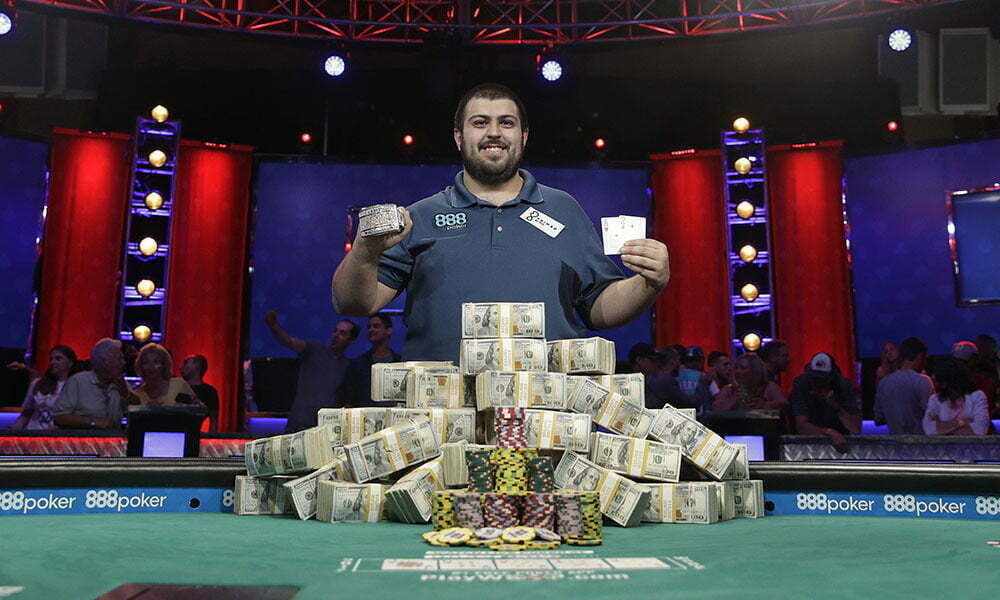Exploring the World Series of Poker


Ever wanted to know more about the World Series of Poker – how it came to be, what goes on behind the scenes? Then take a look as we dive into the history of one of the world’s most famous gambling championships, and perhaps start practising to make an appearance of your own one day. It’s anybody’s game!
What’s it all about?
So what exactly is the World Series of Poker (or the WSOP, as those in the know call it)? Essentially it’s a series of annual poker tournaments, usually held in Las Vegas, that take place over a number of days in June and July. In 2018, the WSOP was made up of a record number of 78 bracelet events, the majority featuring Texas Hold’em, although almost every other known variety of poker was represented as well.
With its 50th annual tournament set to take place this year, the WSOP has come a long way since its humble beginnings in 1969, when the idea of a Poker championship began with an event known as the Texas Gambling Reunion. Held at the Holiday Hotel and Casino in Reno, the event was eventually won by Crandell Addington, and despite its unassuming nature, sparked an idea in the mind of Vegas casino proprietor Benny Binion.
The following year, Binion built on the concept of the Texas Gambling Reunion by holding a series of cash games at Binion’s Horseshoe – an event known today as the first official WSOP. Rather than the glitz and glam of today’s tournaments, the event was a low-key one, taking place in a small alcove, with seven players huddled around tables taking part in games such as Five-Card Stud, Razz, Texas Hold’em and more. With less than 50 poker tables in the whole of Las Vegas, the event received little to no attention, and the eventual winner, Johnny Moss, was voted best player, rather than actually winning the tournament outright. And yet, despite this modest introduction into the world of competitive gambling, the tournament would soon grow beyond its originator’s wildest dreams.
Fast forward two years, and ‘Amarillo Slim’ Preston’s unbelievable win in 1972 took the WSOP from relative obscurity and put it on the map. After emerging as champion from a field of just 12 players, he took his win on an historic tour with him, becoming an ambassador for gaming and the event itself. Not only did Preston appear on The Tonight Show an incredible 11 times, he appeared in movies, wrote a book, and publicised the event to a hugely enthusiastic audience, gaining massive popularity for himself in the process.
The result? A television deal with CBS Sports the following year, and the first-ever broadcast of the WSOP, won by Puggy Pearson. In 1974, Johnny Moss completed a hat-trick of wins by taking his third title, after which Doyle Brunson claimed back-to-back championship titles in 1975 and 1976. From then on, a number of firsts made headlines in the WSOP, with 1978 seeing the tournament’s prize money divided up between all five finishers for the first time, and, even more ground-breakingly, a woman enter the all-male Poker ranks by being the first female to take part in the WSOP.
After this win for feminism by Barbara Freer in 1978, Hal Fowler made his own mark on the WSOP in 1979 by becoming the first amateur player to triumph over the professionals – a feat that many seasoned players weren’t too happy about. As it turns out, however, this accomplishment was a sign of things to come, as many other amateur players, buoyed by Fowler’s victory, began to make their way to Vegas in search of their own WSOP titles.
A household name
If the early years of the WSOP were characterised by growth, the formative years were marked by innovation and increasing popularity. Players like Stu ‘The Kid’ Ungar burst onto the scene in the early 80s, while the now-famous $10,000 Main Event was established, along with a Ladies World Championship as well.
With more international players flocking to the tables, 1990 saw Mansour Matloubi, an Iranian ex-pat from England, win the title, beating out local competition for the first time. Just one year later, the WSOP purse grew to a noteworthy $1 million, bringing over 200 players to the table, and increasing that number to 300 within just five years.
The eventual death of Benny Binion, the exponential growth of the tournament, and the declining fortunes of the Horseshoe itself soon led to whispers that the WSOP was past its prime, particularly when rival championship, the World Poker Tour, launched in 2003. However, thanks to an unbelievable performance from Chris Moneymaker at the WSOP in the same year, the failing tournament immediately found itself revitalised and back on the map.
Moneymaker’s astounding win was a turning point in the fortunes of the WSOP, launching it into the spotlight once more, and turning Poker players into bona fide celebrities – helped in no small part by the live broadcasting of the tournament by ESPN. As the popularity of the tournament escalated, so did the prize money, with Moneymaker netting $2.5 million in 2003, Greg Raymer winning $5 million in 2004, and an ultimate prize of $7.5 million being given away in 2005.
To add to the excitement of the newly energised competition, Harrah’s Entertainment (now known as Caesars Entertainment) bought the Horseshoe, kept the rights to both it and the WSOP tournament and branding, and moved the whole championship to its Rio Hotel and Casino on the Strip – finally a location large enough for the WSOP’s rapidly growing needs. The move to a more appropriate space prompted a flood of players to enter the WSOP from then on, with bracelet events and prize money growing year upon year.
Today the WSOP is widely known as the biggest event in sports, with over $100 million in prize money given away, lucrative partnerships with brands, a World Series of Poker Circuit throughout the USA, and ever-increasing fame and popularity. What once began as a small event with just seven players is now a global phenomenon, and a hugely moneyed one at that, giving avid Poker players round the world the hope that one day they too might be able to sit down to the Main Event and walk away a multi-million dollar winner.
Playing to win at the WSOP
So how exactly does the tournament itself work? Enter one of the many Poker events on offer, and if you’re a winner, you’ll receive a World Series of Poker bracelet, as well as a cash prize, the amount of which is determined by the buy-in amount and the number of players in that specific event. If you really want to show off your skills though, and go head-to-head with the big boys (and girls), it’s the Main Event you’ll want to enter – the $10,000 no-limit Hold’em game that offers a prize in the multi-millions, and a gold bracelet that only the world’s most elite Poker players have ever worn. In fact, win the Main Event and you’ll be widely regarded as the World Champion of Poker, with your picture displayed in the Gallery of Champions at Binion’s.
How do you get to the World Series of Poker? Well, you’ll have to qualify first, which you can do by entering any one of a vast number of satellite tournaments before the WSOP begins. You’ll usually have the choice of entering a single satellite, where one player wins a ticket into the tournament, or a mega satellite, where a number of players will win entry into the event. Similarly, local card room tournaments offer chances to win tickets to the tournament, while the WSOP itself runs satellites allowing players to qualify. Buying into the WSOP can be an expensive exercise, so winning a satellite tournament offers a more cost-effective solution that’s bankroll-friendly.
If you’d prefer not to enter a satellite at a brick and mortar casino, you can always buy your way in online, and take part in any number of satellite tournaments on the internet as well. Take a look at 888.poker.com, PokerStars, and WSOP.com itself, and see about starting your own journey to the event – or if you’re actually in Vegas, you might be lucky enough to win an entry in a raffle in the weeks leading up to the tournament.
Once you’re there it’ll be time to put your game face on, because you’ll be up against players of a world-class calibre, like John Cynn who took the title in 2018 after a mammoth 10-hour struggle against opponent Tony Miles. After having finished in 11th place in 2016, the win was something of a redemptive feat for Cynn, who was humbly appreciative of the opportunity to join the line-up of previous WSOP greats. “To make 11th is insane on its own,” said Cynn after his accomplishment, “and to win, that’s literally something that you dream of but you just never expect to happen. Right now I do feel pretty overwhelmed.”
How overwhelmed would you be if you took the WSOP title? We’re guessing very! But whether that’s a goal you’re keen on playing towards, or you’re happy just to watch the pros go at it from the comfort of your couch, one thing’s for sure – the WSOP is the playground of champions, and one that’s sure to continue being hugely entertaining and rewarding for years to come.
Happy Spinning 🙂 Or should we say, Bluffing 🙂
Pretending poker is glamorous while ignoring its addictive traps is dangerously disappointing.
What an inspiring exploration into the evolution of the World Series of Poker! 😊 The journey from humble beginnings to a global phenomenon is truly remarkable. It’s motivating to see how innovation and determination have shaped such an iconic event, inviting everyone to dream big and aim for the poker stars!